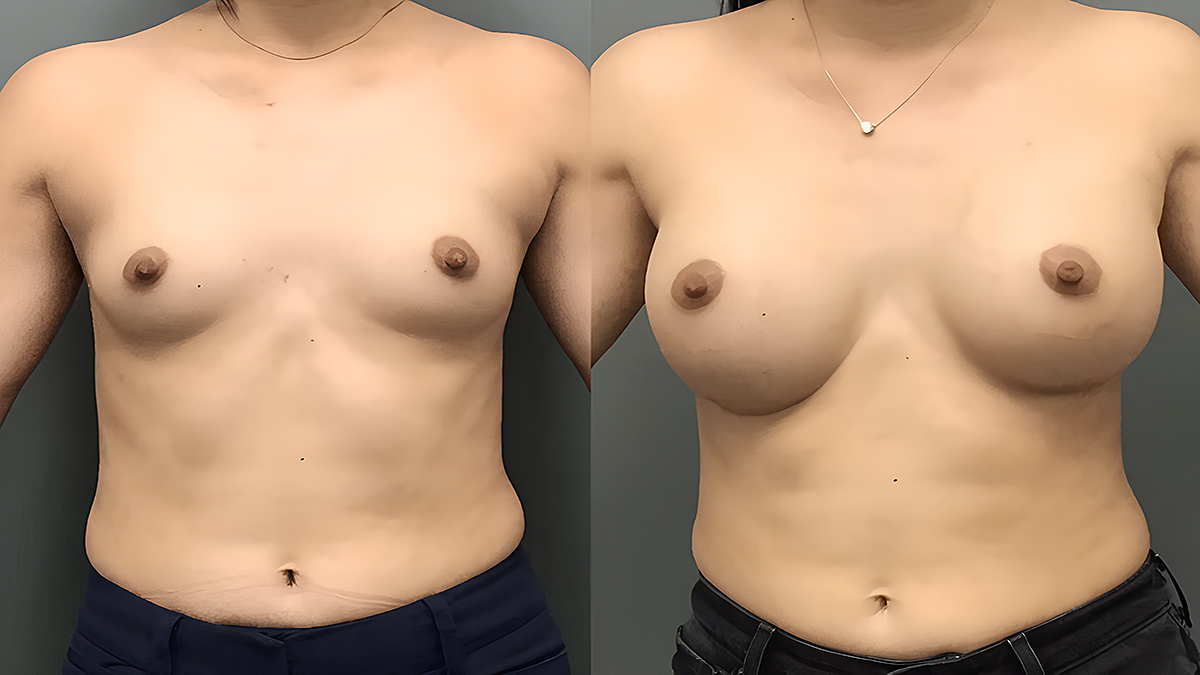
Choosing the right breast implant is a deeply personal decision - one that can shape how you feel in your own skin for years to come. For women in San Antonio and beyond, Dr. Michael Baumholtz, a dual-board-certified Plastic Surgeon, understands that "best" means something different for every patient. With years of experience, advanced tools, and a compassionate approach, Dr. Baumholtz helps guide each woman toward a choice that aligns with her goals, her anatomy, and her lifestyle.
Understanding Breast Implants: More Than Just Size
When patients come to Baumholtz Plastic Surgery in San Antonio, TX, they often start with basic questions about implant types. Understanding the differences is the first step in making an informed decision.
Saline implants are filled with sterile salt water after placement, allowing for greater adjustability during surgery. This makes it easier to correct minor asymmetries on the spot and ensures that the final look is balanced. Because they're inserted empty, these implants allow for smaller incisions, which many patients prefer to minimize visible scarring. If a saline implant ruptures, the saline is safely absorbed by the body and the deflation is immediately noticeable. While they may ripple more in lean patients with thin breast tissue, some women appreciate the peace of mind that comes with knowing a rupture would be easy to detect and harmless.
Silicone implants, by contrast, are pre-filled with a cohesive silicone gel that closely mimics natural breast tissue. Their popularity stems from their soft, natural feel and reduced likelihood of rippling. They are especially suited to women with minimal existing breast tissue who want a more seamless, lifelike result, or women who want implants that feel more like their natural breast tissue. However, unlike saline, a rupture in a silicone implant may not be immediately apparent - often referred to as a “silent rupture” - and may require an MRI or ultrasound for detection. For many patients, the aesthetic benefits of silicone outweigh the added monitoring requirements.
When it comes to implant shape, patients can choose between round and shaped (anatomical) implants. Round implants are symmetrical and provide even fullness, often enhancing the upper part of the breast to create more noticeable cleavage. The design behind shaped implants being tapered is to mimic the natural slope of the breast and appeal to women seeking a more subtle, anatomically correct look. However, because of their fixed shape, there’s a risk they can rotate after surgery, which can distort the appearance of the breast and may require additional surgery to correct. To reduce that risk, shaped implants typically need to be textured or secured with surgical tabs - but texturing has been linked to an increased risk of BIA-ALCL (a rare type of lymphoma), and the tabs can sometimes break away from the surrounding tissue. Dr. Michael Baumholtz considers each patient’s body type and daily activities, including exercise and lifestyle preferences, when recommending the most appropriate shape.
What Makes an Implant the “Best”?
There’s no one-size-fits-all answer. The best implant is the one that aligns with your unique anatomy, lifestyle, and long-term vision for your body - and that includes selecting the right volume and ensuring proper positioning for a natural, lasting result.
Each woman’s body brings a different set of considerations. The width of the chest wall helps determine the ideal base width of the implant to maintain balance and proportion. Skin thickness and elasticity affect how the implant settles and how natural it will look over time. The amount of existing breast tissue plays a role in choosing the implant type and deciding whether it should be placed above or below the muscle. Even the position of your nipples and the breast fold impacts how the implant is positioned and how the final result appears.
But anatomy is only half of the equation. What you want matters just as much. Whether you're after a subtle enhancement or a more noticeable change, selecting an implant with the right volume for your frame is key to avoiding an unnatural or top-heavy result. Dr. Michael Baumholtz uses advanced tools like VECTRA 3D imaging and your own “wish photos” to preview how different volumes and shapes will look on your body. This makes it easier to align your vision with what’s surgically appropriate. From feeling great in your clothes to feeling more confident on the beach, the right implant doesn’t just change your shape - it enhances your everyday experience.
See Before and After Photos of Breast Augmentation Surgery
Behind the Scenes: The Surgical Details That Matter
The artistry of breast augmentation lies in the details. Every choice - from incision location to implant brand - impacts your experience, recovery, and results.
Dr. Baumholtz typically uses the inframammary fold incision, a small, carefully placed cut along the crease beneath the breast. This location allows for better visibility and control during surgery, promotes symmetrical outcomes, and is associated with fewer complications like capsular contracture. It also tends to heal discreetly, blending into the natural contour of the breast.
Smooth implants are Dr. Baumholtz’s preferred choice. They move more naturally within the breast pocket, carry a lower risk of BIA-ALCL compared to textured implants, and are versatile enough to be used in revision surgeries or combined with a mastopexy (breast lift) when reshaping or repositioning the breast is also needed. He works with leading implant manufacturers like Allergan and Motiva, which offer advanced shell designs and cohesive gels to help tailor results to each patient’s goals.
The Keller Funnel is another important tool in Dr. Baumholtz’s technique. This device allows implants to be inserted without direct contact, reducing the risk of contamination and gel damage. It also supports smaller incisions and a more comfortable recovery - benefits many patients appreciate.
For women with thinner tissue or those selecting larger implants, absorbable mesh can provide added support. It helps stabilize the implant, maintain shape, and reinforce the breast structure - especially useful for active patients or those with limited natural volume or in women needing a lift at the time of surgery.
Long-Term Results and Patient Safety
Dr. Baumholtz’s commitment doesn’t stop when the procedure ends. He focuses on long-term success, ensuring patients understand the realistic lifespan of their implants - typically 10 to 15 years or more - and what to expect as time goes on.
Part of that involves educating patients about signs of potential complications, such as rippling, capsular contracture, or rupture. By equipping patients with this knowledge, he helps them feel confident and in control. He also discusses when revision surgery may be appropriate, whether for medical reasons or simply to update one’s look over time. Ongoing follow-up and open communication are essential parts of his care philosophy.
Why Dr. Michael Baumholtz’s Expertise Matters
What sets Dr. Baumholtz apart is not just his board certification in both General and Plastic Surgery, but his approach to complex and revision cases. He brings advanced training in Hand and Microsurgery, which enhances his precision and technique, especially in delicate anatomical work.
Dr. Baumholtz is trusted throughout San Antonio, TX, for his honest guidance and hands-on involvement. Patients frequently mention how comforting it is to know that the same surgeon they meet in consultation will be by their side throughout surgery and recovery. From day one through your final check-up, Dr. Baumholtz is your partner in care.
FAQs About Breast Implants
Can my workout routine affect the type of implant recommended?
Yes. If you engage in regular high-intensity workouts, especially chest-focused exercises, Dr. Baumholtz will take this into account. The implant type, size, and placement (above or below the muscle) can all impact long-term comfort and performance.
What happens if my weight fluctuates after getting implants?
Significant weight gain or loss can affect how your breast implants look and sit over time. While the implants themselves maintain their shape, the surrounding breast tissue and skin may stretch with weight gain or deflate with weight loss. This can change the overall shape, fullness, and symmetry of the breasts - and in some cases, it may impact the position of the implants. For example, weight loss can lead to a loss of upper pole fullness or cause the implant to sit lower if the skin becomes looser, while weight gain might create a heavier appearance or shift the implant in relation to your natural tissue. These changes don’t happen overnight, but if your weight tends to fluctuate significantly, it’s worth discussing this with your surgeon during the consultation to help choose an implant and surgical approach that offers the best long-term result.
Are there any lifestyle changes I’ll need to make post-surgery?
For the initial weeks post-surgery, you’ll need to limit upper body activity, avoid heavy lifting, and sleep on your back. Long-term, most women return to their regular routines without restrictions, but always check in with Dr. Baumholtz if you have lifestyle concerns.
How does breast implant choice affect future mammograms?
Breast implants can slightly change the way mammograms are performed, but they do not prevent you from having regular breast cancer screenings. Implants, especially those placed in front of the muscle, can obscure some breast tissue on standard imaging. To ensure accurate results, a specialized technique called implant displacement views is often used, where the implant is gently moved aside so the radiologist can examine more of the natural breast tissue. During your consultation, Dr. Baumholtz will explain how your specific implant placement and type may affect imaging. He also advises choosing radiology centers with experience in screening patients with implants, so that your mammograms remain effective, thorough, and as comfortable as possible.
Can breast implants change how my natural breast tissue ages?
Over time, natural aging processes like tissue laxity or gravity still occur. However, the presence of an implant may slightly alter how the breast maintains volume and position.
How do I know if I might need mesh reinforcement?
Dr. Baumholtz evaluates several factors during your consultation, including tissue thickness, breast skin quality, and your implant size preferences. Mesh is typically considered when additional internal support is needed - especially for women with thinner tissue, those choosing larger implants, or in procedures that involve a breast lift (mastopexy). In lift cases, mesh can help support the reshaped breast and maintain implant position over time, reducing the risk of bottoming out or early drooping. It acts like an internal bra, giving added structure where your natural tissue may not be strong enough on its own.
Will implants limit my ability to breastfeed in the future?
While many women are able to breastfeed after augmentation, individual outcomes vary. Dr. Baumholtz discusses placement and technique strategies during your consultation to preserve breastfeeding potential whenever possible.
Medical References
- Breast Augmentation - StatPearls - NCBI Bookshelf
This comprehensive overview covers breast augmentation procedures, implant types, and outcomes. It is a reliable educational resource from the U.S. National Library of Medicine.
https://www.ncbi.nlm.nih.gov/books/NBK482206/ - Recognizing and Managing Breast Implant Complications: A Review for Healthcare Providers - National Center for Biotechnology Information (2025)
A detailed review aimed at healthcare providers, covering implant types, surgical approaches, complications, diagnosis, and management strategies.
https://pmc.ncbi.nlm.nih.gov/articles/PMC12067747/
Your Next Step Toward Confidence
The “best” breast implant isn’t something you find on a chart - it’s something you discover through a thoughtful, personalized process. At Baumholtz Plastic Surgery in San Antonio, Dr. Michael Baumholtz blends science, skill, and compassion to help women make choices that enhance their bodies and their lives.
If you're ready to explore your options with a trusted Plastic Surgeon who listens, plans, and delivers with care, visit the website to schedule your consultation with Dr. Michael Baumholtz in San Antonio, TX. It’s time to start your journey with confidence.
Further Reading
- Read Dr Baumholtz Breast Augmentation Procedure
- Read Dr Baumholtz Breast Implant Revision Procedure
- Read more about Saline vs. Silicone Implants - Which One is Better?
- Read more about Types of Breast Implants



